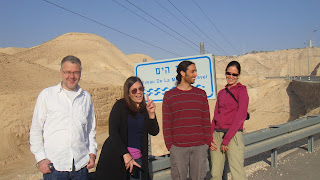Way back in January...
The day after we went to Beit Guvrin, we (Amit, Thomas, Theresa, Marisa, and I) went to Masada and Qumran and St. George's Monastery. After an early start -- we had everyone in the car by 8am -- we headed east into the West Bank and down, down, down to the Dead Sea.
(Photo credits: TT)
 |
| At sea level on the descent to the Dead Sea |
|
Our first stop was at the southwest shore of the Dead Sea, in Israel: Masada.
Masada
Masada is an ancient hilltop fortress; Herod the Great build a castle here in the 1st century BCE. The drama happened from 66-70 CE when the Romans were quashing the Jewish Revolt. A thousand or so Jewish holdouts (some say zealots) refused to accept Roman rule. They retreated from Jerusalem to Masada and withstood the Roman attack for some months (maybe up to 4 years). When it became clear that the Romans had breached the entrance to the fortress the Jews committed group suicide (someone killed someone else until the last guy committed suicide). The legionnaires scaled the plateau to find it deathly quiet.
The archaeological excavations make Masada an amazing place to visit. You can get a good sense of how life on the plateau was organized, and you can see where the Roman troops camped out. We hiked up the snake trail (up the east side of the mountain) and took the cable car down.
 |
| Up the snake path |
 |
| a break on the climb |
 |
| nearly there |
In Herod's time the fortress included a swimming pool, a quarry, a commandant's residence, storerooms, a bathhouse, officers' quarters, a synagogue, a guardroom, an administration building, and a complex water cistern system. Later the Byzantines occupied the fortress and constructed a church and a monastery.
 |
| buildings on top |
 |
| model of Masada |
 |
| half excavated half reconstructed |
 |
| side view of the fortress walking to the northern palace |
Views from the top:
 |
| view to the Dead Sea |
 |
| wadi near Masada |
 |
| the parking lot on the west side of Masada |
 |
| TT, CC, AT |
After leaving Masada we stopped a bit north at Ein Gedi for lunch at a picnic bench near the Dead Sea. (We didn't stop for a swim or float this time.)
Qumran
To get to Qumran you drive north on Hwy 90 back through the checkpoint and into the West Bank. Qumran is located near the northwest shore of the Dead Sea; it's dry and rocky like Masada. We quickly checked out the museum -- the cheesy video at the entrance was a bit off-putting. There isn't much to see at Qumran. Jewish settlement dates to the 8th century BCE, but what really makes it famous is that the Essenes, a break-away Jewish sect, lived there for two centuries -- somewhere between 150 BCE until 68 CE when they were conquered by the Romans during the Jewish Revolt.
Fast forward nearly 2000 years.
In 1947 (these dates according to the Israel Nature and Parks Authority pamphlet), seven scrolls were found by Bedouin shepherds -- legend says they were looking for a lost sheep. (This is believable as we did a short hike up behind the museum into the hills; the terrain is tremendously rugged and there are endless caves that a wayward sheep could explore.) Shortly after the scrolls were found, French archaeologists began excavations in the area. Cutting what must have been a long story short, viola! the French found more scrolls and determined this must have been the site of the Essene settlement.
So what?
Well, these scrolls are the very Dead Sea Scrolls that are on display at the Shrine of the Book at the Israel Museum in Jerusalem. Turns out the Essenes were committed scribes (and ascetics) and they transcribed books of the Old Testament, the Apocrypha, and some of their own sect's works. They stored the rolled scrolls in jars that they tucked into the crevices and caves of Qumran: An ancient library!
 |
| view down the wadi, east to the Dead Sea |
 |
| hiking up |
 |
| a cave where a scroll might have been |
 |
| Shrine of the book -- where the scrolls are now |
 |
| coming down |
St George Monastery
Turning west off of hwy 90 onto hwy 1 and climbing back above sea level we turned north and switched religions. Wending our way down a road that seemed to go nowhere, but provided great views, we found the car park and path to Wadi Qelt. The Lonely Planet describes Wadi Qelt as a naturalist's treat. Indeed it is. And, St. George's Monastery is a spectacular 5th century structure built into the rock face. We arrived too late for a tour inside the Monastery, but the hike down to the wadi was fantastic. There are rare sightings of flowing surface water in Israel, and this one was a delight. There are remnants of old Roman aqueducts and the greenery is lovely...and best of all is the sound of running water!
 |
| looking into Wadi Qelt |
 |
| St. George's Monastery |
 |
| St. George's Monastery |
 |
| greenery in the wadi |
 |
| TT, CC, ML, AT |
Then we hiked up out of the wadi, piled into the car and drove back to Jerusalem. We were exhausted from our very successful touristic weekend.






















No comments:
Post a Comment